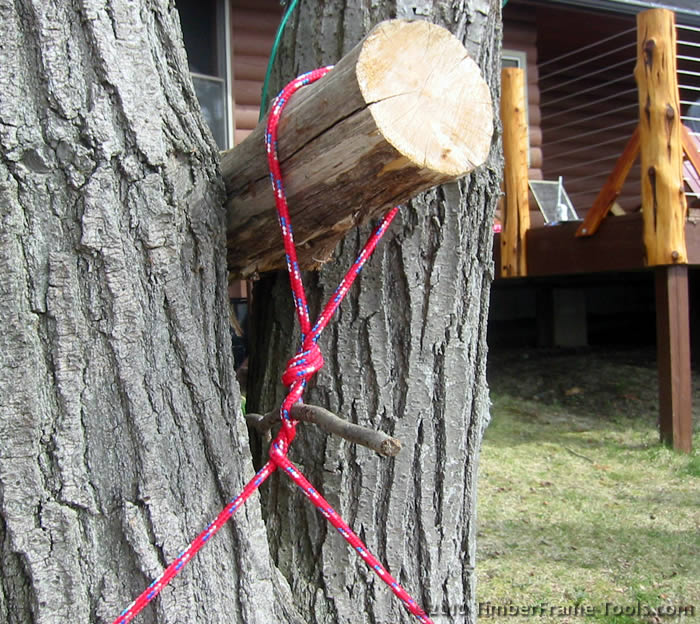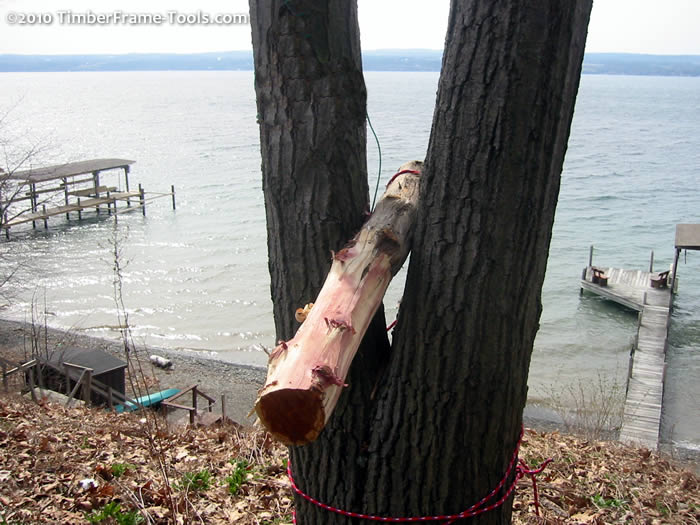I’ve done quite a bit of work around here using old cedar logs as posts for deck railing, gates and light posts. The wood is readily available as the forests near by seem full of old dead cedar trees that couldn’t keep up with the oaks and other giants. When the cedars died, their roots eventually gave up so the trees fell over, but the branches and trunks remained pretty solid despite years of weathering. They need cleaning up, and for that I turn to my drawknife.
The drawknife works great for removing remaining bark and the softer white sap wood to get to the red heartwood that is both attractive and rot resistant. The drawknife is the right tool for the job, but it is only half of what is needed. For the drawknife to work well, the wooden subject needs to be securely held so the knife can pull against it. If the log is not securely held, it will move the first time the knife slams into a knot. That creates a safety issue. I have long struggled with the best way to hold these sizable logs. (6-8 inches in diameter).
I’ve always liked the idea of the shaving horse, but the scale doesn’t seem to work. The jaws of the shaving horse seem better suited for stock in the ballpark of 3″ in diameter or less.

This bench cradle has two birdsmouths ~18" apart. The base gets clamped to the bench and the log being shaved gets pulled against a stop (oak board clamped vertically to the leg of my workbench.
I’ve tried a variety of nylon straps to strap it to the workbench combined with various cradles and stops. They work fairly well, but they take longer to set-up than it takes to shave the top portion, then a lot of reconfiguring as I rotate the wood, then a little bit of shaving, then more re-configuring. It is pretty time consuming for what should be a quick task.

This is usually easier to use than the cradle on the bench.
When the weather is good, I make use of the crotch of an oak tree in front of the house. I set up a rope with a loop on the opposite side of the log to counter-balance it. Using a stick through the rope, I can pretty rapidly tighten or loosen it to adjust the height. I can get to the top and the sides of the log pretty easily too as there is no real support to get in the way of the drawknife handles.

The knot can be tightened or loosened by tilting the stick and twisting the rope.
Shaving away on the log with the great view and sounds of the lake is pretty awesome. It is the kind of harmony I seek out. The only real drawback to using the crotch of the oak is that the bark from the oak is pretty tough and can mar the surface of the post severely. It is not a problem for the first end, but when I flip the post end for end to get the finished end is now in the jaws of the oak. Once I have the log completely shaved, then I clean up the dented damaged areas a bit with the post unsecured. Sometimes placing one end against the ground, the other against my chest, and lightly shaving just to remove the damaged wood. (not completely safe, but the shavings are light so there is not a lot of force to cause things to move unexpectedly).

Between the view and the sound of the waves, it makes me not care that I don't have a "proper" shaving horse.
For intermediate stock (~3″ diameter) I’ve used my version of the saw bench to hold the wood with a pipeclamp and a pair of hand-screws. This was actually pretty effective as long as I only had a few pieces to do (like the spindles for a deck gate I was making).

By using the pipe clamp feature of my saw bench, I can clamp a hand-screw to the bench, and a second hand-screw sets the elevation. It makes a pretty effective shaving bench for mid-sized pieces as long as you don't have too many to complete.
Recently I’ve made a shaving rig for my saw bench. I’ll be posting about that soon.
 Rockler used to sell something they called the “Log Wedge” which was kind of a bad name, given that wedges are meant for splitting and this was meant for peeling, but it was a pretty simple design that allowed you to quickly mount a small log in one of 3 openings and the log’s own weight would essentially hold it in place. My guess is they stopped selling it because a few too many logs sprung loose during shaving and knocked out several teeth.
Rockler used to sell something they called the “Log Wedge” which was kind of a bad name, given that wedges are meant for splitting and this was meant for peeling, but it was a pretty simple design that allowed you to quickly mount a small log in one of 3 openings and the log’s own weight would essentially hold it in place. My guess is they stopped selling it because a few too many logs sprung loose during shaving and knocked out several teeth.